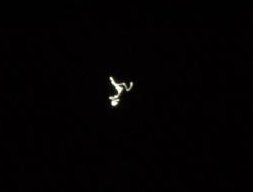News ReleasePITCAIRN ISLAND TO BE PART OF INTERNATIONAL SPACE STATION
CLOUD-MAKING EXPERIMENT PITCAIRN ISLAND, SOUTH PACIFIC OCEAN, May 13, 2009
---- In the early morning of Friday, May 15, several people on this small island
will begin photographing a unique space event that will be visible to the unaided
eye only from Pitcairn and Easter islands. In cooperation with a request
by NASA, at shortly after 5 a.m., on May 15 the Pitcairners will begin photographing
a man-made, fish-hook-shaped cloud in the eastern sky created by the venting of
a large amount of ammonia into space from the International Space Station (ISS).  |  |  | The
International Space Station transiting at 350 km above earth, along with its surrounding
ammonia cloud, as photographed from Pitcairn Island on May 15, 2009, by Pitcairner
David Brown. |
The possibly glowing, fish-hook-shaped cloud
will appear to be attached to a bright point of light which will be the ISS, according
to a NASA spokesman. The photographic study of the unusual, scientifically
important cloud may allow scientists to get significant fundamental knowledge
of the processes of freezing and evaporation of the ammonia ice in space, and
its interactions with the highest reaches of Earth's atmosphere. The whole
scene will be somewhat larger than the moon, and will move quickly across the
sky. The ISS will be clearly visible during this transit because at that time
of day the Pitcairn region of the Pacific will be still in darkness, in shadow
of the limb of the Earth, while the ISS will be bathed in bright sunlight as it
flies 350 kilometers high, up above the shadow. "Your video and still
photos will tell us a lot about what to expect in the future," said Dr. Jack
Bacon, a space station program integration officer at NASA's Johnson Space Center
in Texas, in asking for photographic help from the Pitcairners. According
to Bacon, scientists will not have another opportunity to get the data from such
a venting for many years. The ISS will pass between Pitcairn and Easter
islands about 14 minutes after it starts the ammonia venting over Hawaii. Special
telescopes there will record the beginning of the operation which will not be
visible to the unaided eye. Later in the ISS's orbit, special telescopes
in Siberia, Russia will also contribute to the observations, recording the re-entry
of the ammonia ice into the atmosphere. Soliciting Pitcairn's help in the
experiment, Bacon said, "You have a unique chance to be part of this world-wide
observation campaign, recording how the plume has evolved after the pass over
Hawaii. You, and Easter Island, will be the only two places on Earth that will
have a chance to see the plume with standard personal video equipment, so we especially
seek your help and involvement." On Pitcairn Island Mrs. Kari Young
said, "A number of people here have video motion picture and digital still
cameras, so if the phenomenon is visible here it will be recorded for NASA's use." "The
ISS is the culmination of a decade of cooperative work by 15 countries, and is
currently the size of a football stadium. It houses a permanent international
crew in rotating missions lasting up to six months for each crew member. The crew
will soon double from three to six, and scientific operations will greatly increase
in the next few months," Bacon told the Pitcairners in his appeal for their
help. "Thank you for your participation in this international science
event." ### Pitcairn Islands Study Center, 1 Angwin
Ave., Angwin, CA, USA. Herbert Ford, 707-965-6625, 707-965-2047, Fax: 707-965-6504,
Email: hford@puc.edu, Website: http://library.puc.edu/pitcairn | 




